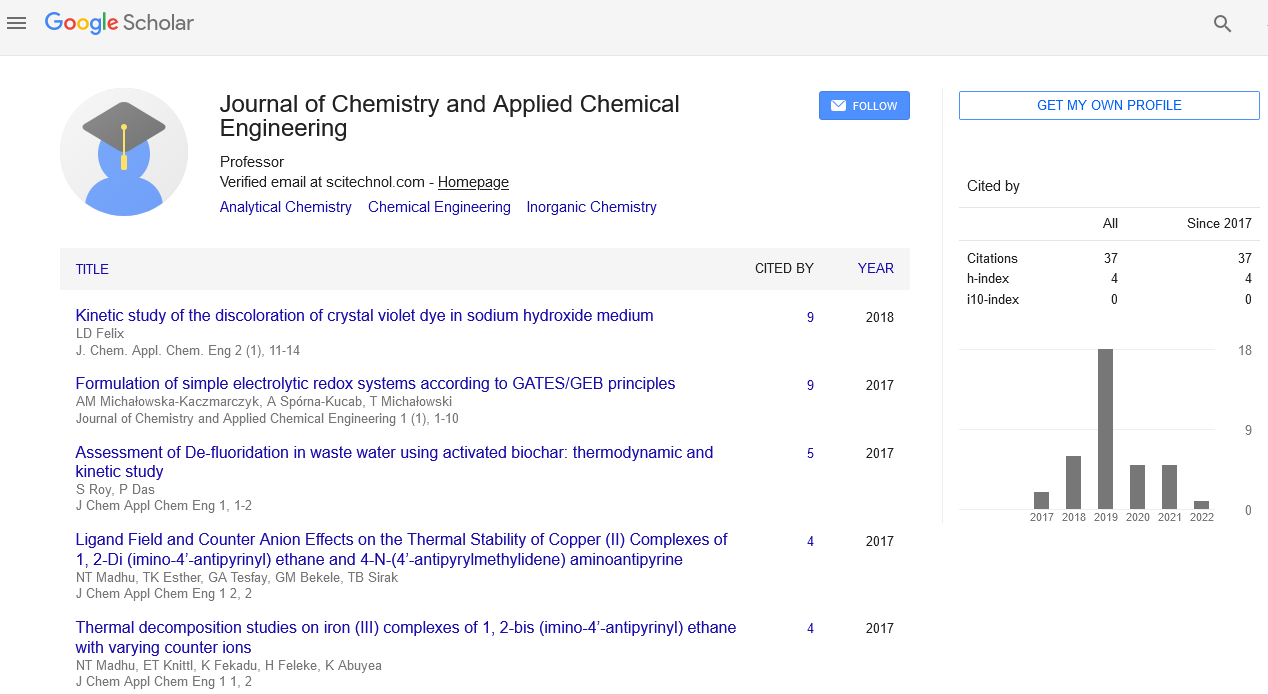Short Communication, J Chem Appl Chem Eng Vol: 7 Issue: 3
Understanding Physical Changes in a Substance during Chemical Reactions
Amair Sahaed*
1Department of Chemical and Biomolecular Engineering, Rice University, Houston, USA
*Corresponding Author: Ahmed Sayed,
Department of Chemical and
Biomolecular Engineering, Rice University, Houston, USA
E-mail: ahmed11sayed@gmail.com
Received date: 30 August, 2023, Manuscript No. JCACE-23-116797;
Editor assigned date: 01 September, 2023, Pre QC No. JCACE-23-116797 (PQ);
Reviewed date: 15 September, 2023, QC No. JCACE-23-116797;
Revised date: 22 September, 2023, Manuscript No. JCACE-23-116797 (R);
Published date: 29 September, 2023, DOI: 10.4172/Jcace.1000037
Citation: Sahaed A (2023) Understanding Physical Changes in a Substance during Chemical Reactions. J Chem Appl Chem Engl 7:3.
Description
Chemical reactions are fundamental processes that govern the transformation of matter in our world. They occur all around us, from the combustion of fuel in an engine to the baking of a cake in the oven. These reactions are not just limited to laboratories; they are part of our daily lives. One of the key aspects of chemical reactions is the change they bring about in substances, which can be categorized into two main types: physical changes and chemical changes [1-3]. Physical changes are alterations in the physical properties of a substance without changing its chemical composition. This means that the individual atoms and molecules in the substance remain the same before and after the change. Some common examples of physical changes include changes in state (e.g., melting, freezing, and evaporation), changes in shape or size, and changes in color or texture. Physical changes are often easier to reverse compared to chemical changes [4,5]. For instance, if you melt an ice cube, you can reverse the process by freezing the water back into ice. Similarly, if you crumple a piece of paper, you can smooth it out to its original shape without altering the chemical composition of the paper.
Physical changes in chemical reactions
Physical changes can occur within a chemical reaction, and understanding them is important to understanding the overall process. Many chemical reactions involve changes in temperature [6]. For example, when water is heated, it turns into steam, which is a gaseous state. This change in state is a physical change, as the chemical composition of water (H2O) remains the same. Some chemical reactions result in a visible change in color. This is often due to the formation of new compounds with different absorption and reflection properties. An example is the browning of an apple when exposed to air, which is a result of oxidation [7-9]. Gas-producing reactions can lead to significant changes in volume. For instance, when baking soda (sodium bicarbonate) and vinegar (acetic acid) react, they produce carbon dioxide gas, which leads to the expansion of the mixture, causing it to foam and bubble. The density of a substance can change during chemical reactions. For example, when hydrogen peroxide (H2O2) decomposes into water (H2O) and oxygen (O2) due to the breaking of chemical bonds, the resulting substances have different densities [10].
Distinguishing physical and chemical changes
In a chemical change, the substances involved undergo a change in their chemical composition, resulting in the formation of new substances. In contrast, physical changes preserve the original chemical composition. Chemical changes are typically irreversible. Once a chemical reaction has occurred, it's challenging to return the substances to their original state. In contrast, physical changes can often be reversed.
Conclusion
Understanding the distinction between physical changes and chemical changes during a chemical reaction is essential in the fields of chemistry and beyond. By recognizing physical changes, scientists can better comprehend the overall transformation of substances. Moreover, this knowledge is valuable in practical applications, such as industrial processes, cooking, and environmental science. Whether it's the melting of ice cream on a hot summer day or the combustion of gasoline in a car engine, physical changes play a significant role in our everyday experiences and the world of chemistry.
References
- Croissant J, Zink JI (2012) Nanovalve-controlled cargo release activated by plasmonic heating. J Am Chem Soc 134(18):7628–7631.
- Zink J (2014) Photo-redox activated drug delivery systems operating under two photon excitation in the near-IR. Nanoscale 6(9): 4652-4658.
- Langer R (2010). Nanotechnology in drug delivery and tissue engineering: From discovery to applications. Nano Lett 10(9): 3223-3230.
- Abrigo M, Arthur M, Kingshott P (2014) Electrospun nanofibers as dressings for chronic wound care : Advances, challenges, and future prospects. Macromolecular Bioscience 14(6): 772-792.
- Xiang DX, Chen Q, Pang L, Zheng Cl (2011) Inhibitory effects of silver nanoparticles on H1N1 influenza A virus in vitro. J Virol Methods 78(1): 137-142.
- Brunet R, Boer D, Guillén-Gosálbez G, Jiménez L (2015) Reducing the cost, environmental impact and energy consumption of biofuel processes through heat integration. Chem Eng Res Des 93: 203-212.
- Kautto J, Realff MJ, Ragauskas AJ, Kässi T (2014) Economic analysis of an organosolv process for bioethanol production. Bio Resources 9(4): 6041-6072.
- Nguyen TTH, Kikuchi Y, Noda M, Hirao M (2015) A new approach for the design and assessment of bio-based chemical processes toward sustainability. Ind Eng Chem Res 54(20): 5494-5504.
- Rajendran K, Rajoli S, Teichert O, Taherzadeh MJ (2014) Impacts of retrofitting analysis on first generation ethanol production: Process design and techno-economics. Bioprocess Biosyst Eng 38(2): 389-397.
- Rossetti I, Lasso J, Compagnoni M, Guido GD (2015) H2 Production from Bioethanol and its use in fuel-cells. Chem Eng Trans 43: 229-234.
 Spanish
Spanish  Chinese
Chinese  Russian
Russian  German
German  French
French  Japanese
Japanese  Portuguese
Portuguese  Hindi
Hindi 